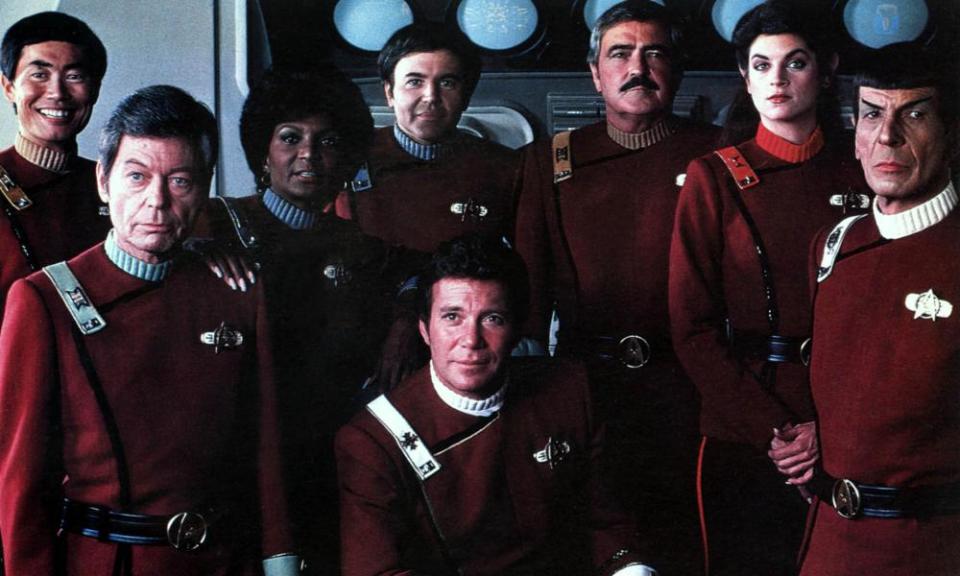‘KHAAAAN!’: why Wrath of Khan remains the greatest Star Trek movie, 40 years on

When JJ Abrams began rebooting Star Trek with a fresh cast and crew of the Enterprise in 2009, many hardcore Trekkers complained that the new movies lacked the Apollo-era optimism and vision of space adventure as one giant cosmic morality tale that, in their view, had made the long-running saga stand out from its peers. Gone were slow-paced allegories playing on contemporary western culture, its triumphs and its horrors. In were hectic space battles, time travel, a strange obsession with motorbikes and plenty of fisticuffs.
What many of these critics failed to notice, was that this dichotomy between Star Trek as blockbuster space opera and thinking-man’s sci-fi had been going on for at least three decades before Abrams even got his hand on the Enterprise’s tiller. And to this day, the series’ greatest movie, Star Trek II: The Wrath of Khan, only succeeded because it broke all the rules expected from an episode of Gene Roddenberry’s creation.
The Nicholas Meyer-directed 1982 film, which celebrates 40 years since its UK release this year, was a low budget follow-up to 1979’s Star Trek: The Motion Picture. That film lifted a storyline straight out of the 1960s original series: something about a nefarious energy cloud later revealed as an ancient human space probe refitted by aliens that has subsequently achieved sentience and turned on Earth. The plot was so nebulous that even Spock struggled to work out what was going on. It duly picked up middling reviews and was a box-office disappointment for studio Paramount, largely due to its gargantuan (for the time) $44m shooting budget.
Out went Roddenberry (as producer) and in came Meyer to write and direct the project, with a much more frugal $12m budget. As well as including some juicy sci-fi stylings such as the Genesis terraforming program, Meyer, who knew nothing about Star Trek, spotted early on that the sequel needed an antagonist for William Shatner’s Admiral James T Kirk to face off against if it was to achieve the right level of big screen theatricality. The perfect solution was to bring back Ricardo Montalbán’s Khan Noonien Singh from the 1967 TV episode Space Seed, about a group of dangerous superhumans encountered by the crew of the Enterprise, who are left stranded by Kirk on an uninhabited but fertile planet.
At the time this is intended to be a merciful decision by the captain, an alternative to being sent to a penal colony for their crimes. But of course, we swiftly find out in Wrath of Khan that the supposedly perfect world picked by Kirk turned out to be in an unstable region of space, and that most of Khan’s people ended up dead or starving when a neighbouring planet subsequently exploded. Oops.
Cue a Melvillian battle between the two men as Khan takes out 15 years of frustration on his nemesis. Montalbán chews scenery like it’s an Ikea showroom made out of prime steak, yet crucially never slips too far into the realms of pantomime. The veteran Mexican actor remains a terrifying, vengeful force of nature, rage personified, throughout.
At the end of each episode of the original series, there was usually the sense that the Enterprise could fully reset, with danger averted and normal duties resumed. By contrast, the events of Wrath of Khan are so horrific that they can never be forgotten, and the level of threat seems to have been suddenly upped to warp factor 9.9.
Walter Koenig’s Chekov, along with newcomer Clark Terrell (captain of the USS Reliant) are mind-controlled by Khan using hideous space slugs that are painfully, and bloodily lodged inside their ears! Spock dies of radiation poisoning trying to restart the Enterprise’s warp engine! Khan himself is left to die once again after being summarily outwitted by his supposed inferiors. Where The Motion Picture was mildly intriguing, Wrath of Khan represents blood-pumping, big screen shock tactics on an epic scale.
Thirty years later, Abrams tried to recapture its magic with an effective remake, Star Trek Into Darkness. But even with Benedict Cumberbatch as a younger version of Khan (who crucially never got marooned by Kirk in the new timeline, so was really just a boring, big-headed eugenics experiment in human form) most of the original’s bloodthirsty lust for life and death failed to re-manifest.
Into Darkness was once voted hardcore fans’ least favourite Star Trek movie, a nadir for anyone who loved the original series’ more intellectual, cosmic musings. Yet it was all based on a movie that had to destroy everything that went before it, everything that fans expected from a Star Trek episode, just to keep the Enterprise from crashing down to earth for ever.

 Yahoo Finance
Yahoo Finance 